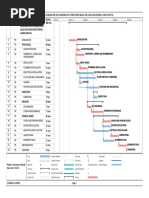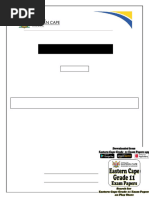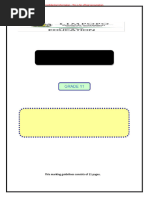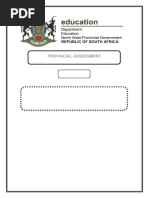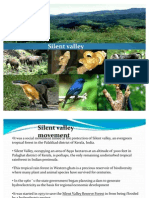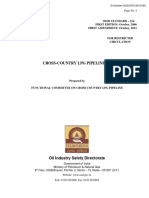Geography p2 Memo Gr11 Nov2022 - English
Geography p2 Memo Gr11 Nov2022 - English
Uploaded by
thandothemane253Copyright:
Available Formats
Geography p2 Memo Gr11 Nov2022 - English
Geography p2 Memo Gr11 Nov2022 - English
Uploaded by
thandothemane253Original Title
Copyright
Available Formats
Share this document
Did you find this document useful?
Is this content inappropriate?
Copyright:
Available Formats
Geography p2 Memo Gr11 Nov2022 - English
Geography p2 Memo Gr11 Nov2022 - English
Uploaded by
thandothemane253Copyright:
Available Formats
sapapers.co.
za
NATIONAL
SENIOR CERTIFICATE
GRADE 11
NOVEMBER 2022
GEOGRAPHY P2
MARKING GUIDELINE
MARKS: 150
This marking guideline consists of 9 pages.
2 GEOGRAPHY P2 (EC/NOVEMBER 2022)
SECTION A: DEVELOPMENT GEOGRAPHY AND RESOURCES AND
SUSTAINABILITY
QUESTION 1
1.1 1.1.1 E (industrialisation) (1)
1.1.2 G (transnational corporations) (1)
1.1.3 A (globalisation) (1)
1.1.4 B (foreign trade) (1)
1.1.5 C (multiplier-effect) (1)
1.1.6 H (developed) (1)
1.1.7 E (sustainable development) (1) (7 x 1) (7)
1.2 1.2.1 A (1)
1.2.2 C (1)
1.2.3 A (1)
1.2.4 C (1)
1.2.5 D (1)
1.2.6 B (1)
1.2.7 A (1)
1.2.8 D (1) (8 x 1) (8)
1.3 1.3.1 An increase in the total of value of goods and services produced by a
country in one year (2)
[CONCEPT] (1 x 2) (2)
1.3.2 There would be an increase in the economy (1)
Indicates an increase in formal employment and formal business (1)
Policymakers and banks can make future positive plans to grow the
economy further (1)
[ANY ONE] (1 x 1) (1)
1.3.3 GDP growth increases the living standards and quality of life of
people/An increase in the living standards and quality of life of people
leads to further GDP growth (2) (1 x 2) (2)
1.3.4 Despite GDP growth there are still many people that live in
poverty/‘could I at least get something to eat’ (2) (1 x 2) (2)
Copyright reserved Please turn over
(EC/NOVEMBER 2022) GEOGRAPHY P2 3
1.3.5 Unequal distribution of wealth in a country (Gini-coefficient) (2)
GDP growth focuses on money and not on developing the social capital
in a country (2)
Social tension as the poor are marginalised (2)
Racial tension as minority groups are excluded from the mainstream
economy (2)
GDP growth depletes natural resources and robs people of their
livelihoods (2)
[ANY TWO] (2 x 2) (4)
1.3.6 Improve the levels of literacy by making education more accessible (2)
Introducing a variety of skills programs to make more people employable
in the formal and informal sectors (2)
Provision of services (accept examples) to improve the quality of life (2)
Improving the Gender Inequality Index so that more women are
represented in politics, education and high-level jobs (2)
Improving food security in a country to reduce poverty (2)
[ANY TWO] (2 x 2) (4)
1.4 1.4.1 Process where community members come together to take collective
action to enhance development (2)
[CONCEPT] (1 x 2) (2)
1.4.2 Skills and training opportunities (1)
Jobs and business opportunities (1)
[ANY ONE] (1 x 1) (1)
1.4.3 Socio-economic development of impoverished communities (1)
Significantly improves the well-being of households in rural
communities (1)
Early childhood initiatives (1)
Health care initiatives (1)
Community awareness (1)
Woman and child empowerment (1)
[ANY TWO] (2 x 1) (2)
1.4.4 Monitoring makes sure that the skills acquired are correctly implemented
and maintained (2)
It makes sure that participants in the programmes can confront any
challenges (2)
To ensure the community has a livelihood (2)
The whole community benefits in all age groups (2)
[ANY ONE] (1 x 2) (2)
Copyright reserved Please turn over
4 GEOGRAPHY P2 (EC/NOVEMBER 2022)
1.4.5 It centres around the development of human resources (2)
It enhances organising and develops administrative skills (2)
Helps with the understanding of health care and health services (2)
Helps with nation building (2)
It improves infrastructure and modern technology usage (2)
It increases the standard of living and empowers women (2)
To ensure community members are uplifted through increased
incomes (2)
It helps with agricultural expansion and food security (2)
[ANY FOUR] (4 x 2) (8)
1.5 1.5.1 BRICS (1) (1 x 1) (1)
1.5.2 China (1)
India (1)
Russia (1)
[ANY TWO] (2 x 1) (2)
1.5.3 A trade policy meant to protect the economy of one or certain countries
by limiting imports and increasing exports (2)
[CONCEPT] (1 x 2) (2)
1.5.4 There is a free trade agreement (without tariffs) among the 5 member
countries (1)
Sanctions are imposed on trade with other countries (1)
Tariffs, duties and customs are imposed on other countries exporting
goods to the BRICS countries (1)
Quotas are imposed on the amount of goods entering the country (1)
BRICS countries allocate import subsidies to local producers when
goods are imported (1)
Governments of BRICS countries allocate export subsidies to local
producers to enable them to sell at reduced prices to foreign
consumers (1)
[ANY ONE] (1 x 2) (2)
1.5.5 They advocate a free trade policy to increase their economic growth (2)
Strengthen their manufacturing base and create more jobs (2)
They benefit from an exchange of goods and services at reduced
costs (2)
They can develop market-orientated policies and encourage private
investment (2)
[ANY TWO] (2 x 2) (4)
Copyright reserved Please turn over
(EC/NOVEMBER 2022) GEOGRAPHY P2 5
1.5.6 They could receive humanitarian aid (e.g. vaccines) to decrease the
spread/deaths among skilled/educated members of the workforce (2)
Trade through exports can assist domestic manufacturers a decrease
retrenchment (2)
Investment in different sectors of the economy from other member
countries could increase jobs (2)
Imports can provide essential/specialised components to different
sectors of the economy (2)
Loans at favourable interest rates could help subsidise businesses to
re-establish themselves (2)
[ANY TWO] (2 x 2) (4)
[60]
QUESTION 2
2.1 2.1.1 B (1)
2.1.2 C (1)
2.1.3 D (1)
2.1.4 C (1)
2.1.5 A (1)
2.1.6 B (1)
2.1.7 D (1) (7 x 1) (7)
2.2 2.2.1 Downslope (1)
2.2.2 subsistence (1)
2.2.3 Biofuel (1)
2.2.4 Western Cape (1)
2.2.5 gas (1)
2.2.6 Afforestation (1)
2.2.7 climate (1)
2.2.8 Fallowing (1) (8 x 1) (8)
2.3 2.3.1 Logging (1)
Ranching (1)
Mining (1)
Agriculture (1)
[ANY ONE] (1 x 1) (1)
Copyright reserved Please turn over
6 GEOGRAPHY P2 (EC/NOVEMBER 2022)
2.3.2 Wind (1)
Floods (1)
Rains (1)
[ANY TWO] (2 x 1) (2)
2.3.3 Loss of natural habitat (2)
Loss of trees (2)
Endanger species (2)
Loss of depth of species (2)
Extinction of ethnic tribes (2)
[ANY ONE] (1 x 2) (2)
2.3.4 Loss of vegetation which helps land to retain water and top soils /
provides rich nutrients to sustain environment (2)
Increase in run-off as vegetation does not protect soil (2)
Silting of dams due to sedimentation in streams effects waterways
and fish/species (2)
Desertification created due to removal of trees due to run-off (2)
Gullies created due to removal of trees due to run-off (2)
[ANY TWO] (2 x 2) (4)
2.3.5 Contour ploughing (2)
Crop rotation (2)
Rotational grazing (2)
Increase vegetation cover (2)
Plant groundcover between row crops (2)
Protect grasslands (2)
Drainage basin management (2)
Conserving rivers and wetlands (2)
Public education (2)
[ANY THREE] (3 x 2) (6)
2.4 2.4.1 Eskom (1) (1 x 1) (1)
2.4.2 Job losses (1)
Halve the GDP (1) (2 x 1) (2)
2.4.3 Failure to build new power stations to keep up with economic
growth (1)
Reduced production from ageing/faulty equipment (1)
Mismanagement and corruption (1)
No renewable energy to supplement the grid (1)
[ANY TWO] (2 x 1) (2)
2.4.4 The private sector can generate its own power and sell the excess
back to the grid. (2) (1 x 2) (2)
Copyright reserved Please turn over
(EC/NOVEMBER 2022) GEOGRAPHY P2 7
2.4.5 Large amounts of money have been invested in coal mines/power
stations (2)
They provide jobs and contribute to the GDP (2) (2 x 2) (4)
2.4.6 Degradation/alteration of the land occurs because of mining (2)
Biodiversity is reduced (2)
Habitats of ecosystems are destroyed (2)
Methane (greenhouse gas) is released that contributes to global
warming (2)
Acid mine drainage cause water pollution (2)
[ANY TWO] (2 x 2) (4)
2.5 2.5.1 It is an energy source that can naturally replenish itself (2)
[CONCEPT] (1 x 2) (2)
2.5.2 Lowers the demand and use of fossil fuels (1) (1 x 1) (1)
2.5.3 It is a threat to wildlife e.g. birds (2)
Destroys ecosystems (2)
Destruction of habitats (2)
Removing natural vegetation/deforestation is required to set
up wind farms (2)
It is not aesthetically pleasing/visual pollution (2)
[ANY ONE] (1 x 2) (2)
2.5.4 Located at latitudes that receive enough sunlight to cause
pressure differences (2)
The coastline provides enough windy areas for its energy to be
harnessed (2)
[ANY ONE] (1 x 2) (2)
2.5.5 It is cheaper as it only requires wind to work (2)
Creates jobs in the setting up and maintenance of wind turbines (2)
People learn skills that could be put to use in other sectors of the
economy (2)
Maintenance costs are minimal (2)
It is affordable for homeowners and businesses to set up their own
power grids (2)
Farmers can rent out land to wind farms (2)
It is a green source of energy which saves the country on fines for
excessive carbon emissions (2)
[ANY FOUR] (4 x 2) (8)
[60]
TOTAL SECTION A: 120
Copyright reserved Please turn over
8 GEOGRAPHY P2 (EC/NOVEMBER 2022)
SECTION B: GEOGRAPHICAL SKILLS AND TECHNIQUES
QUESTION 3
3.1 The questions below are based on the 1 : 50 000 topographical map 3319
AD Ceres, as well as the orthophoto map of a part of the mapped area.
3.1.1 Length = 2,7 x 100 = 270 m
Breadth = 2,0 x 100 = 200 m
270 (1) m x 200 (1) m = 54 000 m² (1) (3 x 1) (3)
3.2 3.2.1 (a) The Toll House (1) (1 x 1) (1)
(b) Mitchell’s Pass (1) (1 x 1) (1)
3.2.2 concave (1) (1 x 1) (1)
3.2.3 VS = 1 cm : 20 m
VS = 1 cm : (20 x 100) cm
VS = 1 : 2 000 (1) (as a ratio)
HS = 1 : 50 000 (1) (as a ratio)
VE= 1 : 2 000 (1) (substitution)
1 : 50 000
1 50 000
x
2 000 1
25 times (1) (4 x 1) (4)
MAP INTERPRETATION
3.3 3.3.1 Vertical aerial photograph (1) (1 x 1) (1)
3.3.2 Vertical:
Photograph is taken at an angle of 90° (2)
Photograph taken with camera axis directed towards the ground
vertically (2)
[ANY ONE] (1 x 2) (2)
3.3.3 There is a lack of vegetation (2) (1 x 2) (2)
3.4 3.4.1 B cemetery (1) (1 x 1) (1)
3.4.2 D cutting (1) (1 x 1) (1)
3.5 3.5.1 C (1) (1 x 1) (1)
3.5.2 Flat land (2)
Availability of water/irrigation possible – canals/furrows (2) (2 x 2) (4)
Copyright reserved Please turn over
(EC/NOVEMBER 2022) GEOGRAPHY P2 9
GEOGRAPHICAL INFORMATION SYSTEMS (GIS)
3.6 3.6.1 Power line (1) (1 x 1) (1)
3.6.2 It is an arterial route, or it is the R46 (1)
Tar road (1)
Road in a north easterly / south westerly direction (1)
Straight road (1)
Runs through an urban area (1)
Stop streets through built up area (1)
[ANY ONE] (1 x 1) (1)
3.7 3.7.1 Remote sensing:
Getting information about the earth/object from a distance (without
being in contact with the earth/object) (2)
[CONCEPT] (1 x 2) (2)
3.7.2 They need to analyse where the industrial areas are found in relation
to the rivers/other water sources (2)
Pinpointing specific industries within a certain radius of a water source,
may locate cause (2)
Take aerial photographs and compare changes in water quality of the
river (water colour, water temperature, water density, algae …) (2)
Take river samples to determine if farmers are polluting water source
through fertilisation/sprays of vineyards/orchards (2)
Use aerial photograph of the area can be added as a layer or ‘theme’
which may also shed some light on the matter (2)
Remotely sensed data valuable tool in monitoring water quality in
different water sources (2)
[ANY TWO] (2 x 2) (4)
[30]
TOTAL SECTION B: 30
GRAND TOTAL: 150
Copyright reserved Please turn over
You might also like
- Construction ScheduleDocument1 pageConstruction ScheduleWoodlock Limited100% (6)
- LEARNER ACTIVITIES Economic Geography Possible Answers 2020Document25 pagesLEARNER ACTIVITIES Economic Geography Possible Answers 2020Thabiso Kabelo MunxuseniNo ratings yet
- #304 Cargo Operation - DischargingDocument3 pages#304 Cargo Operation - DischargingTolias Egw100% (1)
- Geography p2 Memo Gr11 Nov2022 - EnglishDocument9 pagesGeography p2 Memo Gr11 Nov2022 - EnglishMyWork IRLesolangNo ratings yet
- GEOGRAPHY P2 MEMO GR11 NOV2022 - EnglishDocument10 pagesGEOGRAPHY P2 MEMO GR11 NOV2022 - Englishmabuzanontokozo72No ratings yet
- Grade 11 Term 3 Marking Guideline - CorrectedDocument4 pagesGrade 11 Term 3 Marking Guideline - CorrectedlesegomugodiNo ratings yet
- Memo Geog 11 P2 2024 FinalDocument11 pagesMemo Geog 11 P2 2024 Finalmatodziraphalalani6No ratings yet
- Geog - Grade 11 MG - Topic Test 02 Aug 2024Document3 pagesGeog - Grade 11 MG - Topic Test 02 Aug 2024Humphrey MahloNo ratings yet
- GEOG Grade 11 Term 3 Test Marking GuidelineDocument5 pagesGEOG Grade 11 Term 3 Test Marking Guidelineligegemulondi8No ratings yet
- 221124 NW 11 GEOGRAPHY P2 MG ENGDocument8 pages221124 NW 11 GEOGRAPHY P2 MG ENGThando SizweNo ratings yet
- Geog P2 MG EngDocument9 pagesGeog P2 MG EngJoas NhombokaNo ratings yet
- Geography p2 Memo Gr11 Nov2020_eng dDocument9 pagesGeography p2 Memo Gr11 Nov2020_eng dZizile NgcoboNo ratings yet
- Geography Grade 11 (Marking Guide) Pre-Controlled Term 3 2022 - 220830 - 121307Document4 pagesGeography Grade 11 (Marking Guide) Pre-Controlled Term 3 2022 - 220830 - 121307Portia MakwenjeNo ratings yet
- Geography p2 Gr11 Memo Nov2024 - EnglishDocument12 pagesGeography p2 Gr11 Memo Nov2024 - Englishnkosiphiledennay607No ratings yet
- 8 Geography Grade 11 Trade and Development Answer SheetDocument13 pages8 Geography Grade 11 Trade and Development Answer Sheetmashudu.makungo8No ratings yet
- Grade 11, Geography, MARKING GUIDELINES Term 3 Test 2022Document5 pagesGrade 11, Geography, MARKING GUIDELINES Term 3 Test 2022kiashbehariNo ratings yet
- Geography-NSC-P2-Memo-Sept-2022-Eng LimpopoDocument11 pagesGeography-NSC-P2-Memo-Sept-2022-Eng LimpopoLegendary JuniorNo ratings yet
- Grade 11, Geography, MARKING GUIDELINES Term 3 Test 2022Document5 pagesGrade 11, Geography, MARKING GUIDELINES Term 3 Test 2022modigandlovu2kNo ratings yet
- 2024 Geog GR 12 Pre-Mid Year p2 Marking GuidelineDocument11 pages2024 Geog GR 12 Pre-Mid Year p2 Marking Guidelinenokomolokomme01No ratings yet
- 2024 Geog Econ MGDocument6 pages2024 Geog Econ MGhockerblessingNo ratings yet
- ECONOMICS P1 GR11 MEMO NOV 2023 - EnglishDocument16 pagesECONOMICS P1 GR11 MEMO NOV 2023 - Englishearlyyan07No ratings yet
- 2022 T3 Gr11 Controlled Test MG- ENGDocument9 pages2022 T3 Gr11 Controlled Test MG- ENGSithole ArthurNo ratings yet
- Geography P2 GR 11 Exemplar 2022 MG EngDocument11 pagesGeography P2 GR 11 Exemplar 2022 MG EnglesegomugodiNo ratings yet
- Grade 11 Exam Bank DevelopmentDocument54 pagesGrade 11 Exam Bank Developmentrivisimusa09No ratings yet
- Economics P1 June-July 2015 Memo EngDocument19 pagesEconomics P1 June-July 2015 Memo EngprettyboymteeNo ratings yet
- Economics p1 Gr11 Memo Nov 2023 - English (1) - 1Document16 pagesEconomics p1 Gr11 Memo Nov 2023 - English (1) - 1nhlanhlanhlapho133No ratings yet
- Geography P2 GR 10 EDocument11 pagesGeography P2 GR 10 EMashudu NemakondeNo ratings yet
- Geography P2 Gr 11 Exemplar 2022 MG Eng-1Document11 pagesGeography P2 Gr 11 Exemplar 2022 MG Eng-1Pfano MadalaNo ratings yet
- 2024 Grade 12 Test MemoDocument5 pages2024 Grade 12 Test Memodaylinallie2007No ratings yet
- 2023 Geography Grade 11 Test 2 Marking GuidelineDocument4 pages2023 Geography Grade 11 Test 2 Marking Guidelinemodigandlovu2kNo ratings yet
- November 2020: Gauteng Department of Education Provincial ExaminationDocument15 pagesNovember 2020: Gauteng Department of Education Provincial ExaminationmasekwamengsehudukeNo ratings yet
- Memo Grade 11 Errata Test 2 2023Document2 pagesMemo Grade 11 Errata Test 2 2023modigandlovu2kNo ratings yet
- Economics P1 Grade 12 September 2024 MG FINALDocument14 pagesEconomics P1 Grade 12 September 2024 MG FINALnaledithobeliNo ratings yet
- Geo t3 Learner AnswersDocument21 pagesGeo t3 Learner Answersu11307057No ratings yet
- ECONOMICS P1 GR11 MEMO NOV 2023 - EnglishDocument16 pagesECONOMICS P1 GR11 MEMO NOV 2023 - EnglishritotruthNo ratings yet
- Gr11 ECN P1 (English) June 2019 Possible AnswersDocument17 pagesGr11 ECN P1 (English) June 2019 Possible Answersnomvulapetunia460No ratings yet
- MIDLAND_Geography P2_MARKING GUIDE_GR10Document11 pagesMIDLAND_Geography P2_MARKING GUIDE_GR10Wesley PatsikaNo ratings yet
- Economics Grade 10 Term3 Test Final PaperDocument11 pagesEconomics Grade 10 Term3 Test Final Papermbaliekhumalo13No ratings yet
- Grade 11: Sekhukhune South DistrictDocument12 pagesGrade 11: Sekhukhune South DistrictFrank MakotaNo ratings yet
- MARKING GUIDELINES Grade 10 Eng& AfriDocument7 pagesMARKING GUIDELINES Grade 10 Eng& AfriInnocent NgcoboNo ratings yet
- Marking Guidlines Geography Grade 12Document5 pagesMarking Guidlines Geography Grade 12Dalowly VïïNo ratings yet
- 2022 Econ Grade 11 P 1 MGDocument27 pages2022 Econ Grade 11 P 1 MGMinkateko AustinNo ratings yet
- Geography p2 QP Gr11 Nov2022 - English FinalDocument16 pagesGeography p2 QP Gr11 Nov2022 - English Final9vjmb4yqqkNo ratings yet
- Economics p1 Gr11 Memo Nov2022 - EnglishDocument17 pagesEconomics p1 Gr11 Memo Nov2022 - EnglishritotruthNo ratings yet
- District Test MemoDocument5 pagesDistrict Test Memocivilndlovu13No ratings yet
- GRADE 12 Economic Geography Controlled Test 2021 (1)Document10 pagesGRADE 12 Economic Geography Controlled Test 2021 (1)AmukelaniNo ratings yet
- GR 11 Economics P1 (English) November 2022 Possible AnswersDocument18 pagesGR 11 Economics P1 (English) November 2022 Possible AnswersritotruthNo ratings yet
- Economics P1 Feb-March 2015 Memo EngDocument19 pagesEconomics P1 Feb-March 2015 Memo EngShivannah SinghNo ratings yet
- Economics P1 May-June 2021 MG EngDocument19 pagesEconomics P1 May-June 2021 MG EngTshegofatso JacksonNo ratings yet
- Economics p1 Gr11 Memo Nov2022 - EnglishDocument17 pagesEconomics p1 Gr11 Memo Nov2022 - Englishjmtshali031No ratings yet
- Economics p1 Gr11 Memo Nov2022 - English-1Document17 pagesEconomics p1 Gr11 Memo Nov2022 - English-1Laddiey SneNo ratings yet
- GR 10 Economics P1 AnswersDocument21 pagesGR 10 Economics P1 Answersjrmy5ppt5jNo ratings yet
- ECONOMICS P1 GR11 MEMO NOV 2024 - English - WatermarkDocument23 pagesECONOMICS P1 GR11 MEMO NOV 2024 - English - Watermarkmgybvkpdt9No ratings yet
- Economics P1 Nov 2021 MG EngDocument23 pagesEconomics P1 Nov 2021 MG Eng6wxtqz9wnkNo ratings yet
- Gr10 EC P2 (ENG) June 2022 Possible AnswersDocument13 pagesGr10 EC P2 (ENG) June 2022 Possible Answersmofokenglerato284No ratings yet
- GEOGRAPHY P2 QP GR11 NOV2022 - English FinalDocument17 pagesGEOGRAPHY P2 QP GR11 NOV2022 - English FinaltakadzanijustinmaimelaNo ratings yet
- 2024 Grade 11 Econ p1 MG FinalDocument19 pages2024 Grade 11 Econ p1 MG FinalKoketso MathekgaNo ratings yet
- Economics 2023 FS Prelim P1 MemoDocument20 pagesEconomics 2023 FS Prelim P1 Memojayaby120No ratings yet
- .archECONOMICS P1 GR12 MEMO SEPT 2024 - EnglishDocument22 pages.archECONOMICS P1 GR12 MEMO SEPT 2024 - EnglishHamid RabiuNo ratings yet
- Economics p1 Nov 2022 Memo Eastern CapeDocument18 pagesEconomics p1 Nov 2022 Memo Eastern Capebohlale.mosalaNo ratings yet
- GR 11 Economics P1 (English) November 2022 Possible AnswersDocument18 pagesGR 11 Economics P1 (English) November 2022 Possible AnswerstafenimahleNo ratings yet
- Brochure Damen DredgingDocument40 pagesBrochure Damen Dredginglukman hakim100% (1)
- Refer To The Attached Comment's Sheet: Key PlanDocument1 pageRefer To The Attached Comment's Sheet: Key PlanSyed Munawar AliNo ratings yet
- Appendix I Construction Cost Estimate WorksheetDocument2 pagesAppendix I Construction Cost Estimate WorksheetVenkatesh SankarNo ratings yet
- Higg FEM 2023 Scoring Guidance and ApplicabilityDocument10 pagesHigg FEM 2023 Scoring Guidance and ApplicabilitysabrinasultananuraniNo ratings yet
- Socotra Trek ToursDocument3 pagesSocotra Trek Toursvobom45331No ratings yet
- Morphometric Analysis of A Drainage BasiDocument18 pagesMorphometric Analysis of A Drainage BasiJOHN WILLIAMNo ratings yet
- Caracterizacion Hidrodinamica en Un Estuario Tropical de SuramericaDocument17 pagesCaracterizacion Hidrodinamica en Un Estuario Tropical de SuramericaANDRES FERNANDO HERNANDEZ CUERVONo ratings yet
- Permeability Test in The Field by Pumping From Wells: Water Table Before PumpingDocument2 pagesPermeability Test in The Field by Pumping From Wells: Water Table Before PumpingmikeNo ratings yet
- KURTDocument16 pagesKURTArc Dela CruzNo ratings yet
- Power Generation Systems (Chapter-11)Document5 pagesPower Generation Systems (Chapter-11)bnnaif.72No ratings yet
- Howarth 2000Document14 pagesHowarth 2000hmasadulislam58No ratings yet
- Untitled DocumentDocument2 pagesUntitled DocumentMerylcyne Bangsao SimsimNo ratings yet
- What Are The Different Types of PollutionDocument9 pagesWhat Are The Different Types of PollutionPatricia DurandNo ratings yet
- DOMEKT - VERSO - Installation and Operation Manual - RHP UNITSDocument32 pagesDOMEKT - VERSO - Installation and Operation Manual - RHP UNITSmihai_1983No ratings yet
- hssb1500t ChaptestbDocument5 pageshssb1500t ChaptestbdiscordewrNo ratings yet
- IPA Neerathon - Employee EngagementDocument14 pagesIPA Neerathon - Employee EngagementSujal ShahNo ratings yet
- Chapter 7: Ocean CirculationDocument62 pagesChapter 7: Ocean CirculationCarol GirottoNo ratings yet
- Taller de Ingles 11 NUEVODocument6 pagesTaller de Ingles 11 NUEVOsamuelvillabNo ratings yet
- SV Plastic PollutionDocument6 pagesSV Plastic Pollutionszymonmaj712No ratings yet
- Water - A Precious ResourceDocument5 pagesWater - A Precious ResourcepamarthijagadeeshwariNo ratings yet
- Capaci 1Document10 pagesCapaci 1Karina De Lima UFCNo ratings yet
- kolay-yds-reading-question-bankDocument14 pageskolay-yds-reading-question-bankdzdrkursatNo ratings yet
- FinalDocument20 pagesFinalAmit Madkar40% (5)
- Indian Salaya Project 2x600MW Power Station Training ManualDocument18 pagesIndian Salaya Project 2x600MW Power Station Training ManualBilal HasanNo ratings yet
- Oisd-Std-214Document73 pagesOisd-Std-214Pradeep KumarNo ratings yet
- Introduction To Fisheries Management - GregorioDocument1 pageIntroduction To Fisheries Management - GregorioMicah Joy MoralesNo ratings yet
- Revised TRA FormDocument4 pagesRevised TRA FormJoemar CaprancaNo ratings yet
- Multimatic - 700-System DiagramsDocument13 pagesMultimatic - 700-System DiagramsenergiarenovadaNo ratings yet
